Search
Search for "click":
(Click here to search this entire website for "click" with Google.)
 |
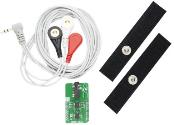
|
|
GSR click bundle - measure the electrical activity of muscles.
|
|
|
|
 |
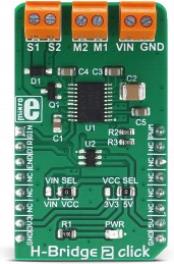
|
|
H-Bridge 2 click can be used to drive a motor by utilizing a specific configuration of the output stage MOSFETs, known as the H-bridge. This configuration enables H-Bridge 2 click to drive a motor with up to 1.2A and 15V, providing control of the speed and direction, as well as the dynamic (rheostatic) braking capability. The Click board™ uses a monolithic H-bridge IC, which implements a set of features that provide trouble-free operation of the connected motor, such as the undervoltage detection, shoot-through current protection, efficient output stage MOSFETs with low RDSON, level shifted output for an external MOSFET control and more. |
|
|
|
 |

|
|
H-Bridge 3 Click is designed for the control of small DC motors and inductive loads, it features TLE9201SG a general purpose 6A H-Bridge perfectly suited for industrial and automotive applications. This IC meets the harsh automotive environmental conditions and it is qualified in accordance with the AEC-Q100 standard, also has set of features such as the short circuit and over-temperature protection, under-voltage protection, detailed SPI diagnosis or simple error flag and fully 3.3/5.5V compatible logic inputs.
H-bridge 3 click is supported by a mikroSDK compliant library, which includes functions that simplify software development. This Click board™ comes as a fully tested product, ready to be used on a system equipped with the mikroBUS™ socket.
|
|
|
|
 |
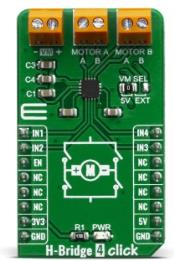
|
|
H-Bridge 4 Click is a Click board™ that contains the AP1010AEN, which is a two channel H-Bridge motor driver compatible with a motor operating voltage up to 18V and can drive two DC motors or one stepper motor. The protection circuit has under voltage lockout circuit, thermal shutdown circuit, and overcurrent protection circuit, and overcurrent protection circuit can be disabled with the DIS OCP terminal.
H-Bridge 4 click supports multiple connection options and can be used in different application setups which might include DC or Stepper motors.
|
|
|
|
 |

|
|
The H-Bridge 5 Click is designed for control DC motors and inductiv loads. This Click board™ contains the MP6515GF-Z, a H-bridge motor driver from MPS, It features an Full H-Bridge driver with Internal safety features include over-current protection, input over-voltage protection, under voltage lockout (UVLO), and thermal shutdown. This click also contains the PCA9538A, a low-voltage 8-bit General Purpose Input/Output (GPIO) expander. The H-Bridge 5 click can be used for Solenoid Drivers and DC Brush Motor Drive.
The H-Bridge 5 click is supported by a mikroSDK compliant library, which includes functions that simplify software development. This Click board™ comes as a fully tested product, ready to be used on a system equipped with the mikroBUS™ socket.
|
|
|
|
 |

|
|
Heart Rate click carries Maxim's MAX30100 integrated pulse oximetry and heart-rate sensor. It's an optical sensor that derives its readings from emitting two wavelengths of light from two LEDs – a red and an infrared one – then measuring the absorbance of pulsing blood through a photodetector. This particular LED color combination is optimized for reading the data through the tip of one's finger. The signal is processed by a low-noise analog signal processing unit and communicated to the target MCU through the mikroBUS I2C interface. Developers of end-user applications should note that the readings can be negatively impacted by excess motion and changes in temperature. Also, too much pressure can constrict capillary blood flow and therefore diminish the reliability of the data. A programmable INT pin is also available. Uses 3.3V power supply. |
|
|
|
 |
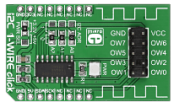
|
|
I2C 1-Wire click carries DS2482, a "bridge device" that performs bidirectional conversions between I2C masters and 1-Wire slave devices. These can be EEPROM chips, temperature sensors and similar devices that have momentary high source current modes. I2C 1-Wire click enables any host with I2C to generate properly timed 1-Wire waveforms to its slave devices. The I2C interface (mikroBUS™ SCL and SDA pins) supports both standard I2C (100kHz max) and fast (400kHz) communication speeds. In addition to the mikroBUS socket, I2C 1-Wire click has an 8-channel pinout (each pin an independently operated 1-Wire I/O). The board is designed to use either a 3.3V or 5V power supply. |
|
|
|
 |

|
|
I2C Extend Click is a compact add-on board for applications that require extending the I2C communication bus over a long distance. This board features the LTC4331 - an I2C slave device extender over a rugged differential link, from Analog Devices. It is a point-to-point SMBus compatible I2C slave device extender, designed for operation in high noise industrial environments while supporting up to 1MHz serial clock, ±40kV ESD protection on link pins, selectable link baud rates and more. All these features make I2C Extend Click an excellent choice for various applications that require extending the I2C bus over a long distance, such as sensor installations, industrial control, lighting system control, sound system control, etc.
I2C Extend Click is supported by a mikroSDK compliant library, which includes functions that simplify software development. This Click board™ comes as a fully tested product, ready to be used on a system equipped with the mikroBUS™ socket.
|
|
|
|
 |
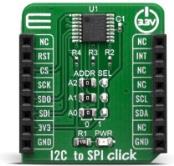
|
|
I2C to SPi Click is an all-in-one solution which allows serving as an interface between a standard I2C-bus of a microcontroller and an SPi bus, which allows the microcontroller to communicate directly with SPi devices through its I2C-bus. It is equipped with the stacking headers, so it can be easily connected. By offering an I2C-bus slave-transmitter or slave-receiver and an SPi master, this Click board™ controls all the SPi bus-specific sequences, protocol, and timing. It also has its own internal oscillator, and it supports the SPi chip select output that may be configured as GPIO when not used.
I2C to SPi Click is supported by a mikroSDK compliant library, which includes functions that simplify software development. This Click board™ comes as a fully tested product, ready to be used on a system equipped with the mikroBUS™ socket.
|
|
|
|
 |
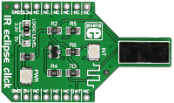
|
|
IR eclipse click carries an EE-SX198 photo interrupter sensor. This sensor consists of an infrared transmitter and receiver facing each other and spaced apart by a 3mm slit. When the beam from the transmitter is eclipsed by placing an object in the slit (like a piece of paper), the sensor is activated (indicated by the onboard INT LED). This type of sensor is typically used in printers, copiers, vending machines and so forth. IR eclipse click communicates with the target board through the mikroBUS INT line. It’s designed to work with either a 3.3V or 5V power supply. |
|
|
|
 |
|
<< First
< Previous
Next >
|
|

